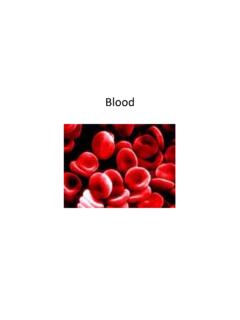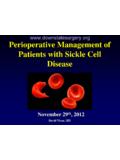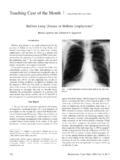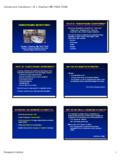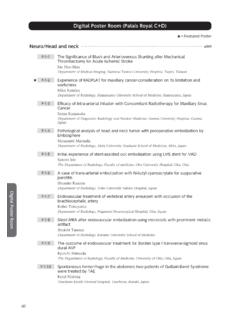Transcription of PULMONARY FUNCTION TESTS - gmch.gov.in
1 PULMONARY FUNCTION TESTSINTRODUCTION PULMONARY FUNCTION TESTS is a generic term used to indicate a battery of studies or maneuvers that may be performed using standardized equipment to measure lung one or more aspects of the respiratory system Respiratory mechanics Lung parenchymal FUNCTION / Gas exchange Cardiopulmonary interactionINDICATIONS DIAGNOSTICPROGNOSTICE valuation of signs & symptoms BLN, chronic cough, exertionaldyspneaAssess severityScreening at risk ptsFollow response to therapyMeasure the effect of Ds on PULMONARY functionDetermine further treatment goalsTo assess preoperative risk Evaluating degree of disabilityMonitor PULMONARY drug toxicityTISI GUIDELINES Age > 70 Obese patients Thoracic surgery Upper abdominal surgery History of cough/ smoking Any PULMONARY diseaseAmerican College of Physicians Guidelines Lung resection H/o smoking, dyspnoea Cardiac surgery Upper abdominal surgery Lower abdominal surgery Uncharacterized PULMONARY disease(defined as history of PULMONARY Disease or symptoms and no PFT in last 60 days)Contraindications Recent eye surgery Thoracic , abdominal and cerebral aneurysms Active hemoptysis Pneumothorax Unstable angina/ recent MI within 1 monthINDEX1.
2 Categorization of PFT s2. Bedside PULMONARY FUNCTION tests3. Static lung volumes and capacities4. Measurement of FRC, RV5. Dynamic lung volumes/forced spirometry6. Physiological determinant of spirometry7. Flow volume loops and detection of airway obstruction8. Flow volume loop and lung diseases9. TESTS of gas exchange function10. TESTS for cardiopulmonary reserve11. Preoperative assessment of thoracotomy patientsCATEGORIZATION OF PFT BED SIDE PULMONARY FUNCTION TESTS STATIC LUNG VOLUMES & CAPACITIES VC, IC, IRV, ERV, RV, FRC. DYNAMIC LUNG VOLUMES FVC, FEV1, FEF 25 75%, PEFR, MVV, RESP. MUSCLE STRENGTHMECHANICAL VENTILATORY FUNCTIONS OF LUNG / CHEST WALL: A)Alveolar arterial po2 gradient B) Diffusion capacity C) Gas distribution TESTS 1)single breath )Multiple Breath N2test 3) Helium dilution method 4) Radio Xe EXCHANGE TESTS : Qualitative TESTS : 1) History , examination 2) ABG Quantitative TESTS 1) 6 min walk test 2) Stair climbing test 3)Shuttle walk 4) CPET(cardiopulmonary exercise testing)CARDIOPULMONARY INTERACTION:INDEX1.
3 Bedside PULMONARY FUNCTION tests2. Static lung volumes and capacities3. Measurement of FRC, RV4. Dynamic lung volumes/forced spirometry5. Flow volume loops and detection of airway obstruction6. Flow volume loop and lung diseases7. TESTS of gas function8. TESTS for cardiopulmonary reserve9. Preoperative assessment of thoracotomy patientsBed side PULMONARY FUNCTION testsRESPIRATORY RATE Essential yet frequently undervalued component of PFT Imp evaluator in weaning & extubation protocols Increase RR muscle fatigue work load weaning fails Bed side PULMONARY FUNCTION tests1)Sabrasez breath holding test:Ask the patient to take a full but not too deep breath & hold it as long as possible. >25 SEC. NORMAL Cardiopulmonary Reserve (CPR) 15 25 SEC LIMITED CPR <15 SEC VERY POOR CPR (Contraindication for elective surgery) 25 30 SEC 3500 ml VC20 25 SEC 3000 ml VC15 20 SEC 2500 ml VC10 15 SEC 2000 ml VC5 10 SEC 1500 ml VCBed side PULMONARY FUNCTION tests2) SCHNEIDER S MATCH BLOWING TEST: MEASURES Maximum Breathing Capacity.
4 Ask to blow a match stick from a distance of 6 (15 cms) with Mouth wide open Chin rested/supported No purse lipping No head movement No air movement in the room Mouth and match at the same levelBed side PULMONARY FUNCTION TESTS Can not blow out a match MBC < 60 L/min FEV1 < Able to blow out a match MBC > 60 L/min FEV1 > MODIFIED MATCH TEST:DISTANCE MBC 9 >150 L/MIN. 6 >60 > 40 L/MINBed side PULMONARY FUNCTION tests3)COUGH TEST: DEEP BREATH F/BY COUGH ABILITY TO COUGH STRENGTH EFFECTIVENESSINADEQUATE COUGH IF: FVC<20 ML/KGFEV1 < 15 ML/KGPEFR < 200 L/MIN.*A wet productive cough / self propagated paraoxysms of coughing patient susceptible for PULMONARY side PULMONARY FUNCTION tests4)FORCED EXPIRATORY TIME:After deep breath, exhale maximally and forcefully & keep stethoscope over trachea & FET 3 5 DIS.
5 > 6 SECRES. LUNG DIS. < 3 SECBed side PULMONARY FUNCTION tests5)WRIGHT PEAK FLOW METER: Measures PEFR (Peak Expiratory Flow Rate)N MALES 450 700 350 500 L/MIN.<200 L/ MIN. INADEQUATE COUGH )DE BONO WHISTLE BLOWING TEST: MEASURES blows down a wide bore tube at the end of which is a whistle, on the side is a hole with adjustable subject blows whistle blows, leak hole is gradually increased till the intensity of whistle the last position at which the whistle can be blown , the PEFR can be read off the S WHISTLEBed side PULMONARY FUNCTION TESTS MICROSPIROMETERS MEASURE VC. BED SIDE PULSE OXIMETRY Bedside PULMONARY FUNCTION tests2. Static lung volumes and capacities3. Measurement of FRC, RV4. Dynamic lung volumes/forced spirometry5. Flow volume loops and detection of airway obstruction6. Flow volume loop and lung diseases7. TESTS of gas function8. TESTS for cardiopulmonary reserve9. Preoperative assessment of thoracotomy patientsSTATIC LUNG VOLUMES AND CAPACITIES SPIROMETRY : CORNERSTONE OF ALL PFTs.
6 John hutchinson invented spirometer. Spirometry is a medical test that measures the volume of air an individual inhales or exhales as a FUNCTION of time. CAN T MEASURE FRC, RV, TLCSPIROMETRY Acceptability Criteria Good start of test without any hesitation No coughing / glottic closure No variable flow No early termination(> 6 sec) No air leak Reproducibility The test is without excessive variabilityThe two largest values for FVC and the two largest values for FEV1should vary by no more than Acceptability CriteriaSpirometry Interpretation: So what constitutes normal? Normal values vary and depend on:I. Height Directly proportional II. Age Inversely proportional III. GenderIV. EthnicityLUNG VOLUMES AND CAPACITIESPFT tracings have: Four Lung volumes: tidal volume, inspiratory reserve volume, expiratory reserve volume, and residual volume Five capacities: inspiratorycapacity, expiratory capacity, vital capacity, functional residual capacity, and total lung capacityAddition of 2 or more volumes comprise a VOLUMES Tidal Volume(TV): volume of air inhaled or exhaled with each breath during quiet breathing (6 8 ml/kg) 500 ml Inspiratory Reserve Volume (IRV): maximum volume of air inhaled from the end inspiratory tidal ml Expiratory Reserve Volume (ERV): maximum volume of air that can be exhaled from resting end expiratory tidal mlLUNG VOLUMES Residual Volume (RV): Volume of air remaining in lungs after maximium exhalation (20 25 ml/kg) 1200 ml Indirectly measured (FRC ERV) It can not be measured by spirometry.
7 LUNG CAPACITIES Total Lung Capacity(TLC): Sum of all volume compartments or volume of air in lungs after maximum inspiration (4 6 L) Vital Capacity (VC): TLC minus RV or maximum volume of air exhaled from maximal inspiratorylevel. (60 70 ml/kg) 5000ml. VC ~ 3 TIMES TV FOR EFFECTIVE COUGH Inspiratory Capacity(IC): Sum of IRV and TV or the maximum volume of air that can be inhaled from the end expiratory tidal position. (2400 3800ml). Expiratory Capacity (EC): TV+ ERVLUNG CAPACITIES Functional Residual Capacity (FRC): Sum of RV and ERV or the volume of air in the lungs at end expiratory tidal position.(30 35 ml/kg) 2500 ml Decreases supine position( 1L) of anesthesia: by 16 20% FUNCTION OF FRC Oxygen store Buffer for maintaining a steady arterial po2 Partial inflation helps prevent atelectasis Minimizes the work of breathing INDEX1. Bedside PULMONARY FUNCTION tests2. Static lung volumes and capacities3. Measurement of FRC, RV4. Dynamic lung volumes/forced spirometry5.
8 Flow volume loops and detection of airway obstruction6. Flow volume loop and lung diseases7. TESTS of gas function8. TESTS for cardiopulmonary reserve9. Preoperative assessment of thoracotomy patientsMeasuring RV, FRCIt can be measured by nitrogen washout technique Helium dilution method Body plethysmographyN2 Washout Technique The patient breathes 100% oxygen, and all the nitrogen in the lungs is washed out. The exhaled volume and the nitrogen concentration in that volume are measured. The difference in nitrogen volume at the initial concentration and at the final exhaled concentration allows a calculation of intrathoracic volume, usually Dilution technique Pt breathes in and out from a reservoir with known volume of gas containing trace of helium. Helium gets diluted by gas previously present in lungs. eg: if 50 ml Helium introduced and the helium concentration is 1% , then volume of the lung is Plethysmography Plethysmography (derived from greek word meaning enlargement).
9 Based on principle of BOYLE S LAW(P*V=k) Priniciple advantage over other two method is it quantifies non communicating gas volumes. A patient is placed in a sitting position in a closed body box with a known volume The patient pants with an open glottis against a closed shutter to produce changes in the box pressure proportionate to the volume of air in the chest. As measurements done at end of expiration, it yields FRCINDEX1. Bedside PULMONARY FUNCTION tests2. Static lung volumes and capacities3. Measurement of FRC, RV4. Dynamic lung volumes/forced spirometry5. Flow volume loops and detection of airway obstruction6. Flow volume loop and lung diseases7. TESTS of gas function8. TESTS for cardiopulmonary reserve9. Preoperative assessment of thoracotomy patientsFORCED SPIROMETRY/TIMED EXPIRATORY SPIROGRAMI ncludes measuring: PULMONARY mechanics to assess the ability of the lung to move large vol of air quickly through the airways to identify airway obstruction FVC FEV1 Several FEF values Forced inspiratory rates(FIF s) MVVFORCED VITAL CAPACITY The FVC is the maximum volume of air that can be breathed out as forcefully and rapidly as possible following a maximum inspiration.
10 Characterized by full inspiration to TLC followed by abrupt onset of expiration to RV Indirectly reflects flow resistance property of VITAL CAPACITYFVC Interpretation of % predicted: 80-120%Normal 70-79% Mild reduction 50%-69%Moderate reduction <50%Severe reductionFVCM easurements Obtained from the FVC Curve and their significance Forced expiratory volume in 1 sec(FEV1) the volume exhaled during the first second of the FVC maneuver. Measures the general severity of the airway obstruction Normal is 3 L Measurements Obtained from the FVC Curve and their significanceFEV1 Decreased in both obstructive & restrictive lung disorders(if patient s vital capacity is smaller than predicted FEV1).FEV1/FVC Reduced in obstructive of % predicted: >75%Normal 60% 75%Mild obstruction 50 59%Moderate obstruction <49%Severe obstructionMeasurements Obtained from the FVC Curve and their significanceForced midexpiratory flow 25 75% (FEF25 75) Max. Flow rate during the mid expiratory part of FVC maneuver.








